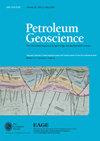伊拉克东北部库尔德斯坦碳酸盐岩储层单元多尺度裂缝长度分析
IF 2.1
4区 地球科学
Q3 GEOSCIENCES, MULTIDISCIPLINARY
引用次数: 1
摘要
裂缝尺度参数是天然裂缝性储层建模的重要输入,但很难从地下数据中得到。伊拉克北部库尔德斯坦地区的大面积暴露为附近的生产和潜在的油气油田提供了有用的露头类似物。各种数据采集方法用于分析上白垩统Aqra-Bekhme组碳酸盐岩裂缝系统。当绘制在长度-强度图上时,整理后的数据位于上方包络线的下方,该包络线在0.1至3000米之间遵循幂律分布,超过5个数量级,并定义了整个地区背景压裂的最大可能强度。等高线长度-强度数据显示了强度在上包络线以下的分布,并允许估计模态强度和最小可能强度。观察到的断裂强度变化的可能原因包括变形的局部性质、靠近高应变带(包括断层)、梯状断裂等二阶效应以及机械分层厚度的变化。专题合集:这篇文章是自然裂缝油藏合集的一部分,可在:https://www.lyellcollection.org/cc/naturally-fractured-reservoirs本文章由计算机程序翻译,如有差异,请以英文原文为准。
Multiscale fracture length analysis in carbonate reservoir units, Kurdistan, NE Iraq
Fracture scaling parameters are an important input for modelling of naturally fractured reservoirs, but are very difficult to derive from subsurface data. Extensive areas of exposure in the northern Kurdistan Region of Iraq provide useful outcrop analogues for nearby producing and potential hydrocarbon fields. A variety of data acquisition methods are used to analyse fracture systems in carbonates of the Upper Cretaceous Aqra–Bekhme Formation across a wide range of scales. When plotted on length–intensity graphs, the collated data lie below an upper envelope that follows a power-law distribution over five orders of magnitude between 0.1 and 3000 m, and which defines the maximum likely intensity of background fracturing across the region. Contouring the length–intensity data shows the distribution of intensities below the upper envelope, and allows modal and minimum likely intensities to be estimated. Likely causes for the observed variation in fracture intensities include the domainal nature of deformation, the proximity to high strain zones including faults, second-order effects such as ladder fractures, and variations in the thickness of mechanical layering. Thematic collection: This article is part of the Naturally Fractured Reservoirs collection available at: https://www.lyellcollection.org/cc/naturally-fractured-reservoirs
求助全文
通过发布文献求助,成功后即可免费获取论文全文。
去求助
来源期刊

Petroleum Geoscience
地学-地球科学综合
CiteScore
4.80
自引率
11.80%
发文量
28
审稿时长
>12 weeks
期刊介绍:
Petroleum Geoscience is the international journal of geoenergy and applied earth science, and is co-owned by the Geological Society of London and the European Association of Geoscientists and Engineers (EAGE).
Petroleum Geoscience transcends disciplinary boundaries and publishes a balanced mix of articles covering exploration, exploitation, appraisal, development and enhancement of sub-surface hydrocarbon resources and carbon repositories. The integration of disciplines in an applied context, whether for fluid production, carbon storage or related geoenergy applications, is a particular strength of the journal. Articles on enhancing exploration efficiency, lowering technological and environmental risk, and improving hydrocarbon recovery communicate the latest developments in sub-surface geoscience to a wide readership.
Petroleum Geoscience provides a multidisciplinary forum for those engaged in the science and technology of the rock-related sub-surface disciplines. The journal reaches some 8000 individual subscribers, and a further 1100 institutional subscriptions provide global access to readers including geologists, geophysicists, petroleum and reservoir engineers, petrophysicists and geochemists in both academia and industry. The journal aims to share knowledge of reservoir geoscience and to reflect the international nature of its development.
 求助内容:
求助内容: 应助结果提醒方式:
应助结果提醒方式:


